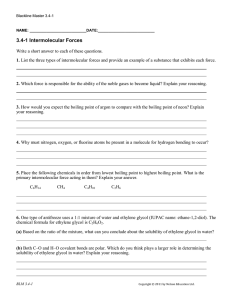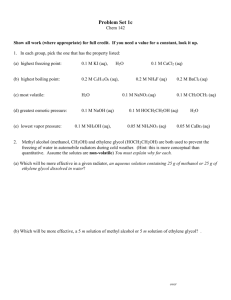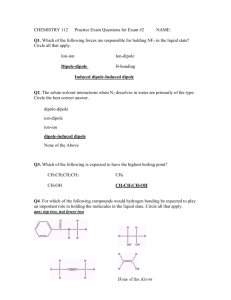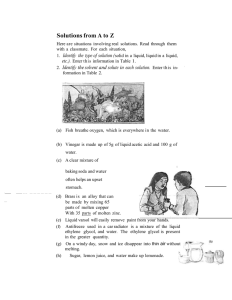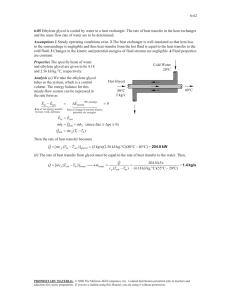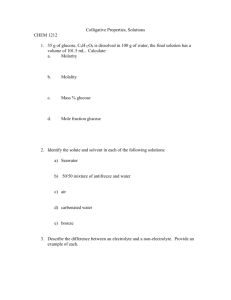SAFETY DATA SHEET Barker Microfarads
advertisement
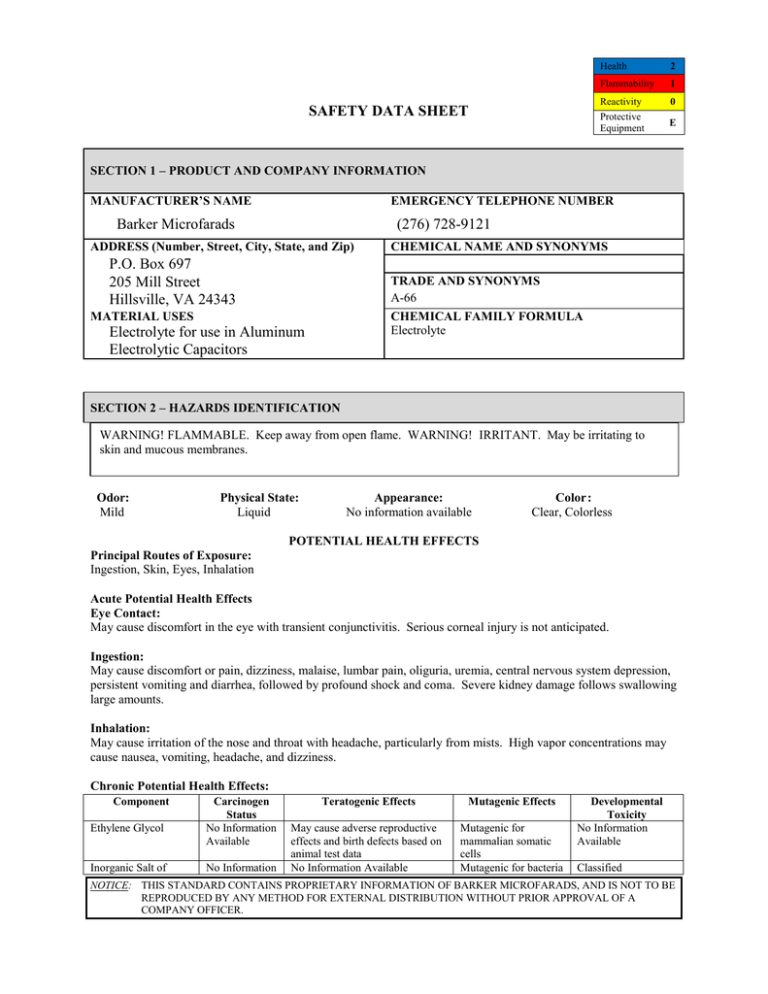
SAFETY DATA SHEET Health 2 Flammability 1 Reactivity 0 Protective Equipment E SECTION 1 – PRODUCT AND COMPANY INFORMATION MANUFACTURER’S NAME EMERGENCY TELEPHONE NUMBER Barker Microfarads (276) 728-9121 ADDRESS (Number, Street, City, State, and Zip) P.O. Box 697 205 Mill Street Hillsville, VA 24343 CHEMICAL NAME AND SYNONYMS TRADE AND SYNONYMS A-66 CHEMICAL FAMILY FORMULA Electrolyte MATERIAL USES Electrolyte for use in Aluminum Electrolytic Capacitors SECTION 2 – HAZARDS IDENTIFICATION WARNING! FLAMMABLE. Keep away from open flame. WARNING! IRRITANT. May be irritating to skin and mucous membranes. Odor: Mild Physical State: Liquid Appearance: No information available Color: Clear, Colorless POTENTIAL HEALTH EFFECTS Principal Routes of Exposure: Ingestion, Skin, Eyes, Inhalation Acute Potential Health Effects Eye Contact: May cause discomfort in the eye with transient conjunctivitis. Serious corneal injury is not anticipated. Ingestion: May cause discomfort or pain, dizziness, malaise, lumbar pain, oliguria, uremia, central nervous system depression, persistent vomiting and diarrhea, followed by profound shock and coma. Severe kidney damage follows swallowing large amounts. Inhalation: May cause irritation of the nose and throat with headache, particularly from mists. High vapor concentrations may cause nausea, vomiting, headache, and dizziness. Chronic Potential Health Effects: Component Ethylene Glycol Inorganic Salt of Carcinogen Status No Information Available No Information Teratogenic Effects Mutagenic Effects May cause adverse reproductive effects and birth defects based on animal test data No Information Available Mutagenic for mammalian somatic cells Mutagenic for bacteria Developmental Toxicity No Information Available Classified NOTICE: THIS STANDARD CONTAINS PROPRIETARY INFORMATION OF BARKER MICROFARADS, AND IS NOT TO BE REPRODUCED BY ANY METHOD FOR EXTERNAL DISTRIBUTION WITHOUT PRIOR APPROVAL OF A COMPANY OFFICER. Boric Acid Available and/or yeast reproductive system/toxin/female, reproductive system/toxin/male SECTION 3 – COMPOSITION/INFORMATION ON INGREDIENTS Components TLV (Units) 50ppm N/A Ethylene Glycol Inorganic Salt of Boric Acid Threshold Limit Value: For vapor and mist combined, based on ethylene glycol; 50ppm ceiling (ACGIH 198485) SECTION 4 – FIRST AID MEASURES General Advice: Ensure that medical personnel are aware of the material(s) involved and take precautions to protect themselves. First aider needs to protect him/herself. Ingestion: Do not induce vomiting. Call a physician or Poison Control Center immediately. Skin Contact: Remove contaminated clothing and flush skin with water. Inhalation: Move to fresh air. Call a physician if discomfort persists. Eye Contact: Immediately flush with water and continue washing the eyes for several minutes. SECTION 5 – FIRE-FIGHTING MEASURES Flashpoint (Closed Cup; ASTM D-56) >212°F Lower Explosion Limit N/A Upper Explosion Limit N/A Extinguishing Media: Alcohol foam, water, water foam, carbon dioxide, dry chemical, carbon tetrachloride. Special Fire-Fighting Procedures: Do not spray pool fires directly with a solid stream of water or foam, as this can cause frothing. Use self-contained breathing apparatus and protective clothing. Unusual Fire and Explosion Hazards: None SECTION 6 – ACCIDENTAL RELEASE MEASURES Personal Precautions: Ensure adequate ventilation. If TLV is exceeded, wear NIOSH approved breathing air equipment or NIOSH approved face mask with organic vapor cartridge and dust or mist pre-filter. Keep people away from spill/leak. Use personal protective equipment. Remove all sources of ignition. NOTICE: THIS STANDARD CONTAINS PROPRIETARY INFORMATION OF BARKER MICROFARADS, AND IS NOT TO BE REPRODUCED BY ANY METHOD FOR EXTERNAL DISTRIBUTION WITHOUT PRIOR APPROVAL OF A COMPANY OFFICER. Environmental Precautions: Prevent further leakage or spillage if safe to do so. Small spills should be flushed with large quantities of water. In case of a large spill, dike if needed. Larger spills should be collected for disposal. Methods for Cleaning Up: Absorb spill with inert material. Contaminated absorbent may be deposited in a landfill or incinerated in a furnace in accordance with local, State, and Federal regulations. Clean contaminated surface thoroughly. SECTION 7 – HANDLING AND STORAGE Handling Technical Measures/Precautions: General exhaust is useful; local exhaust is advisable for elevated temperature use. If TLV is exceeded, respiratory protection must be used (See Section 8). Remove all sources of ignition. Keep away from incompatible materials. Safe Handling Advice: Wear personal protective equipment. Use respiratory protection if TLV is exceeded. Avoid contact with eyes, skin, and clothing. Do not ingest. Keep away from open flame. Do not smoke when using. Handle in accordance with good industrial hygiene and safety practice. Storage Technical Measures/Conditions: Keep container closed in a dry place. Store at room temperature. Keep away from high temperatures and open flame. Store away from incompatible materials. Containers of this material may be hazardous when emptied. Since emptied containers retain product residue (vapor, liquid, and/or solid) all hazard precautions given in this data sheet must be observed. Incompatible Materials: Normally unreactive, however avoid strong bases at high temperatures, strong acids, strong oxidizing agents, and materials reactive with hydroxyl compounds. SECTION 8 – EXPOSURE CONTROLS / PERSONAL PROTECTION Engineering Measures: Local exhaust is advisable for elevated temperature use. General mechanical exhaust is useful to keep the airborne concentrations of vapor and mist below the threshold limit value. Personal Protective Equipment Eye Protection: Monogoggles/face shield. Skin Protection: Rubber or polyvinyl chloride coated gloves. Respiratory Protection: If TLV is exceeded, use NIOSH approved breathing air equipment or NIOSH approved face mask with organic vapor cartridge and dust or mist pre-filter. NOTICE: THIS STANDARD CONTAINS PROPRIETARY INFORMATION OF BARKER MICROFARADS, AND IS NOT TO BE REPRODUCED BY ANY METHOD FOR EXTERNAL DISTRIBUTION WITHOUT PRIOR APPROVAL OF A COMPANY OFFICER. Hygiene Measures: Avoid contact with skin, eyes, and clothing. When using, do not eat, drink, or smoke. Wash hands thoroughly before breaks and immediately after handling the product. Components Ethylene Glycol OSHA 50ppm TWA NIOSH No Data Inorganic Salt of Boric Acid 15mg/m3 TWA No Data ACGIH 50ppm, 127 mg/m3 TWA 2mg/m3 TWA SECTION 9 – PHYSICAL AND CHEMICAL PROPERTIES Physical State: Liquid Appearance: No information available Color: Clear, Colorless Odor: Mild Boiling Point: 268°-273° Specific Gravity (g/cm3): 1.15 Evaporation Rate: <<1 pH: No information available Vapor Density: N/A Freezing Point: No information Available Autoignition Temperature: No information available Vapor Pressure: No information available Upper Explosion Limit (%): No information available Lower Explosion Limit (%): No information available Flash Point: >212°F (Closed Cup) Relative Density: No information available Partition Coefficient (n-octanol/water): No information available Decomposition Temp: No information available Odor Threshold: No information available Solubility in Water: Completely Soluble SECTION 10 – STABILITY AND REACTIVITY Stability: Stable Conditions to Avoid: High temperatures. Open flame. Incompatible materials. Materials to Avoid: Strong bases at high temperatures. Strong acids. Strong oxidizing agents. Materials reactive with hydroxyl compounds. Hazardous Decomposition Products: Burning may produce carbon, carbon monoxide, and/or carbon dioxide. Possibility of Hazardous Reactions: None known. SECTION 11 – TOXICOLOGICAL INFORMATION NOTICE: THIS STANDARD CONTAINS PROPRIETARY INFORMATION OF BARKER MICROFARADS, AND IS NOT TO BE REPRODUCED BY ANY METHOD FOR EXTERNAL DISTRIBUTION WITHOUT PRIOR APPROVAL OF A COMPANY OFFICER. Acute Toxicity: Acute oral toxicity (LD50): 4700 mg/kg [Rat]. Acute toxicity of the vapor (LC50): >200 mg/m3 4 hours [Rat]; based on Ethylene Glycol. Local Effects Skin Irritation: Cause skin irritation. A single prolonged exposure is unlikely to result in the material being absorbed through the skin in harmful amounts. Massive contact with damaged skin may result in absorption of potentially harmful amounts. Eye Irritation: May cause discomfort in the eye with transient conjunctivitis. Serious corneal injury is not anticipated. Inhalation: May cause irritation of the nose and throat with headache, particularly from mists. High vapor concentrations may cause nausea, vomiting, headache, and dizziness. Ingestion: May cause discomfort or pain, dizziness, malaise, lumbar pain, oliguria, uremia, central nervous system depression, persistent vomiting and diarrhea, followed by profound shock and coma. Severe kidney damage follows swallowing large amounts. Behavior/central nervous system can be affected within 0.5 to 12 hours after ingestion. A transient inebriation with excitement, stupor, headache, slurred speech, ataxia, somnolence, and euphoria can occur within the first several hours. At it is metabolized, metabolic acidosis and further central nervous system depression (convulsions, muscle weakness) develop. Serious intoxication may develop to coma associated with hypotonia, hyporeflexia, and less commonly seizures and meningismus within 12 to 24 hours. Chronic Effects Component Ethylene Glycol Inorganic Salt of Boric Acid Carcinogen Status No Information Available No Information Available Teratogenic Effects Mutagenic Effects May cause adverse reproductive effects and birth defects based on animal test data No Information Available Mutagenic for mammalian somatic cells Mutagenic for bacteria and/or yeast Developmental Toxicity No Information Available Classified reproductive system/toxin/female, reproductive system/toxin/male SECTION 12 – ECOLOGICAL INFORMATION Ecotoxicity: No information available Persistence and Degradability: No information available Bioaccumulative Potential: No information available Mobility: No information available Other Adverse Effects: No information available NOTICE: THIS STANDARD CONTAINS PROPRIETARY INFORMATION OF BARKER MICROFARADS, AND IS NOT TO BE REPRODUCED BY ANY METHOD FOR EXTERNAL DISTRIBUTION WITHOUT PRIOR APPROVAL OF A COMPANY OFFICER. SECTION 13 – DISPOSAL CONSIDERATIONS Waste from Residues / Unused Products: Containers of this material may be hazardous when emptied. Since emptied containers retain product residues (vapor, liquid, and/or solid) all hazard precautions given in this data sheet must be observed. Waste must be disposed of in accordance with Federal, State, and Local regulations. SECTION 14 – TRANSPORT INFORMATION UN Number: Not applicable. UN Proper Shipping Name: Not applicable. Transport Hazard Class(es): Not a DOT controlled material. Packing Group: Not applicable. Marine Pollutant: Not applicable. Special Precautions: Not applicable. SECTION 15 – REGULATORY INFORMATION Federal and State Regulations: Ethylene Glycol Illinois Toxic Substances Disclosure to Employee Act: Present Illinois Chemical Safety Act: Present New York Release Reporting List: Present Rhode Island RTK Hazardous Substances: Present Pennsylvania RTK: Present Minnesota: Present Massachusetts RTK: Present Massachusetts Spill List: Present New Jersey: Present Louisiana Spill Reporting: Present TSCA 8(b) inventory: Ethylene Glycol TSCA 4(a) Proposed Test Rules: Ethylene Glycol SARA 313 Toxic Chemical Notification and Release Reporting: Present CERCLA - Hazardous Substances and Reportable Quantity: Ethylene Glycol: 5,000lbs. Inorganic Salt of Boric Acid TSCA 8(b) Inventory: Boric Acid NOTICE: THIS STANDARD CONTAINS PROPRIETARY INFORMATION OF BARKER MICROFARADS, AND IS NOT TO BE REPRODUCED BY ANY METHOD FOR EXTERNAL DISTRIBUTION WITHOUT PRIOR APPROVAL OF A COMPANY OFFICER. Other Regulations: Ethylene Glycol OSHA: Hazardous by definition of Hazard Communication Standard (29 CFR 1910.1200). ENEICS: This product is on the European Inventory of Existing Commercial Chemical Substances. WHMIS (Canada): Class D-2A: Material causing other toxic effects (VERY TOXIC). DSCL (EEC): R-22: Harmful if swallowed. S-46: If swallowed, seek medical advice immediately and show this container or label. Inorganic Salt of Boric Acid OSHA: Hazardous by definition of Hazard Communication Standard (29 CFR 1910.1200). WHMIS (Canada): Class D-2A: Material causing other toxic effects (VERY TOXIC). DSCL (EEC): R36/38 – Irritating to eyes and skin. R40 – Possible risks of irreversible effects. R62 – Possible risk of impaired fertility. S24/25 – Avoid contact with skin and eyes. HMIS (UISA): Health Hazard: 2 Fire Hazard: 1 Reactivity: 0 Personal Protection: E National Fire Protection Association (USA): Health: 1 Flammability: 1 Reactivity: 0 Specific Hazard: Protective Equipment: Gloves, lab coat, dust respirator, splash goggles. Be sure to use an approved/certified respirator or equivalent. Wear appropriate respirator when ventilation is inadequate. SECTION 16 – OTHER INFORMATION Preparation Date: February 1, 1988 Revision Date: November 8, 2013 Reason for Revision: To comply with ANSI Z400.1 Standards The information contained in this data sheet is, to the best of our knowledge and belief, accurate as of the date issued. However, since Barker (BMI) cannot anticipate or control the different conditions under which this information or our products may be used, we make no guarantee that the recommendations will be adequate for all individuals or situations. Each user of the product described herein should determine the safety, toxicity, and suitability of the described product for his particular purpose, and Barker (BMI) assumes no responsibility for damages arising out of the use of the described product. Barker (BMI) makes no warranty, either expressed or implied, regarding the accuracy or reliability of the information in this data sheet, nor shall Barker (BMI) be liable for any loss or damage arising out of the use of the information or the described product. NOTICE: THIS STANDARD CONTAINS PROPRIETARY INFORMATION OF BARKER MICROFARADS, AND IS NOT TO BE REPRODUCED BY ANY METHOD FOR EXTERNAL DISTRIBUTION WITHOUT PRIOR APPROVAL OF A COMPANY OFFICER.
